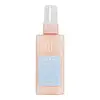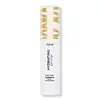What's inside
What's inside
 Key Ingredients
Key Ingredients

 Benefits
Benefits

 Concerns
Concerns

 Ingredients Side-by-side
Ingredients Side-by-side

Water
Skin ConditioningGlycerin
HumectantTriethylhexanoin
MaskingCaprylic/Capric Triglyceride
MaskingDiisostearyl Malate
EmollientPolyglyceryl-6 Stearate
EmollientSodium Hyaluronate
HumectantCocos Nucifera Oil
MaskingArgania Spinosa Kernel Oil
EmollientButyrospermum Parkii Butter
Skin ConditioningPolyglyceryl-6 Behenate
Emulsion StabilisingParfum
MaskingPhenoxyethanol
PreservativeEthylhexylglycerin
Skin ConditioningDisodium EDTA
Water
Skin ConditioningLimnanthes Alba Seed Oil
Skin ConditioningEthylhexyl Stearate
EmollientHydrogenated Poly(C6-14 Olefin)
EmollientMethyl Gluceth-20
HumectantPropanediol
SolventCyclopentasiloxane
EmollientPolyglyceryl-6 Stearate
EmollientDiisostearyl Malate
EmollientGlyceryl Stearate
EmollientPentylene Glycol
Skin ConditioningBetaine
HumectantSodium Stearoyl Glutamate
CleansingSucrose
HumectantPolyglyceryl-6 Behenate
Emulsion StabilisingXanthan Gum
EmulsifyingAcrylates/C10-30 Alkyl Acrylate Crosspolymer
Emulsion StabilisingFructooligosaccharides
HumectantOlea Europaea Fruit Oil
MaskingSaccharide Hydrolysate
HumectantSimmondsia Chinensis Seed Oil
EmollientTromethamine
BufferingVitis Vinifera Seed Oil
EmollientHelianthus Annuus Seed Oil
EmollientParfum
MaskingEthylhexylglycerin
Skin ConditioningPullulan
1,2-Hexanediol
Skin ConditioningBenzyl Benzoate
AntimicrobialDisodium EDTA
Centella Asiatica Extract
CleansingCocos Nucifera Oil
MaskingHouttuynia Cordata Extract
Skin ConditioningSalvia Hispanica Seed Extract
EmollientVegetable Oil
Skin ConditioningTocopherol
AntioxidantPolyacrylate Crosspolymer-6
Emulsion StabilisingT-Butyl Alcohol
PerfumingWater, Limnanthes Alba Seed Oil, Ethylhexyl Stearate, Hydrogenated Poly(C6-14 Olefin), Methyl Gluceth-20, Propanediol, Cyclopentasiloxane, Polyglyceryl-6 Stearate, Diisostearyl Malate, Glyceryl Stearate, Pentylene Glycol, Betaine, Sodium Stearoyl Glutamate, Sucrose, Polyglyceryl-6 Behenate, Xanthan Gum, Acrylates/C10-30 Alkyl Acrylate Crosspolymer, Fructooligosaccharides, Olea Europaea Fruit Oil, Saccharide Hydrolysate, Simmondsia Chinensis Seed Oil, Tromethamine, Vitis Vinifera Seed Oil, Helianthus Annuus Seed Oil, Parfum, Ethylhexylglycerin, Pullulan, 1,2-Hexanediol, Benzyl Benzoate, Disodium EDTA, Centella Asiatica Extract, Cocos Nucifera Oil, Houttuynia Cordata Extract, Salvia Hispanica Seed Extract, Vegetable Oil, Tocopherol, Polyacrylate Crosspolymer-6, T-Butyl Alcohol
Ingredients Explained
These ingredients are found in both products.
Ingredients higher up in an ingredient list are typically present in a larger amount.
Cocos Nucifera Oil is obtained from the kernels of the coconut fruit. In other words, this is coconut oil.
Coconut Oil is rich in fatty acids with lauric acid making up the majority of these. It also contains linoleic acid. Due to this high fatty acid content, coconut oil helps trap moisture and soften skin.
Despite being antibacterial, coconut oil may not be great for acne-prone skin. It is comedogenic and may clog pores. This ingredient may not be safe for malassezia or fungal acne.
Note: Coconut Oil should not replace your sunscreen for UV protection. Studies show it only blocks about 20% of UV.
This oil is non-volatile and has a light scent.
The term 'fragrance' is not regulated in many countries. In many cases, it is up to the brand to define this term. For instance, many brands choose to label themselves as "fragrance-free" because they are not using synthetic fragrances. However, their products may still contain ingredients such as essential oils that are considered a fragrance.
Learn more about Cocos Nucifera OilDiisostearyl Malate is an emollient and most often used in lip products. It comes from isostearyl alcohol, a fatty acid, and malic acid, an AHA.
As an emollient, Diisostearyl Malate helps create a thin film on your skin to trap moisture in. This helps keep your skin soft and smooth.
Disodium EDTA plays a role in making products more stable by aiding other preservatives.
It is a chelating agent, meaning it neutralizes metal ions that may be found in a product.
Disodium EDTA is a salt of edetic acid and is found to be safe in cosmetic ingredients.
Learn more about Disodium EDTAEthylhexylglycerin (we can't pronounce this either) is commonly used as a preservative and skin softener. It is derived from glyceryl.
You might see Ethylhexylglycerin often paired with other preservatives such as phenoxyethanol. Ethylhexylglycerin has been found to increase the effectiveness of these other preservatives.
Parfum is a catch-all term for an ingredient or more that is used to give a scent to products.
Also called "fragrance", this ingredient can be a blend of hundreds of chemicals or plant oils. This means every product with "fragrance" or "parfum" in the ingredients list is a different mixture.
For instance, Habanolide is a proprietary trade name for a specific aroma chemical. When used as a fragrance ingredient in cosmetics, most aroma chemicals fall under the broad labeling category of “FRAGRANCE” or “PARFUM” according to EU and US regulations.
The term 'parfum' or 'fragrance' is not regulated in many countries. In many cases, it is up to the brand to define this term.
For instance, many brands choose to label themselves as "fragrance-free" because they are not using synthetic fragrances. However, their products may still contain ingredients such as essential oils that are considered a fragrance by INCI standards.
One example is Calendula flower extract. Calendula is an essential oil that still imparts a scent or 'fragrance'.
Depending on the blend, the ingredients in the mixture can cause allergies and sensitivities on the skin. Some ingredients that are known EU allergens include linalool and citronellol.
Parfum can also be used to mask or cover an unpleasant scent.
The bottom line is: not all fragrances/parfum/ingredients are created equally. If you are worried about fragrances, we recommend taking a closer look at an ingredient. And of course, we always recommend speaking with a professional.
Learn more about ParfumPolyglyceryl-6 Behenate isn't fungal acne safe.
Polyglyceryl-6 Stearate isn't fungal acne safe.
Water. It's the most common cosmetic ingredient of all. You'll usually see it at the top of ingredient lists, meaning that it makes up the largest part of the product.
So why is it so popular? Water most often acts as a solvent - this means that it helps dissolve other ingredients into the formulation.
You'll also recognize water as that liquid we all need to stay alive. If you see this, drink a glass of water. Stay hydrated!
Learn more about Water